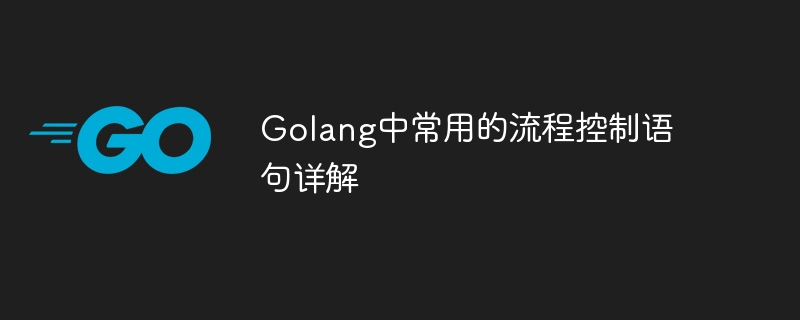Home >Backend Development >Golang >Detailed explanation of commonly used flow control statements in Golang
Detailed explanation of commonly used flow control statements in Golang
- WBOYWBOYWBOYWBOYWBOYWBOYWBOYWBOYWBOYWBOYWBOYWBOYWBOriginal
- 2023-12-23 08:25:17748browse

Detailed explanation of commonly used flow control statements in Golang
As a concurrency-oriented static programming language, Golang provides a wealth of flow control statements to implement complex logic and Conditional judgment. This article will introduce in detail the commonly used flow control statements in Golang, including if statements, switch statements, for statements, etc., and provide specific code examples to deepen understanding.
1. If statement
The if statement is used to execute different code blocks based on conditions. Golang's if syntax structure is as follows:
if condition {
// 如果条件为真,则执行这里的代码
} else {
// 如果条件为假,则执行这里的代码
}Code example:
package main
import "fmt"
func main() {
x := 10
if x > 5 {
fmt.Println("x大于5")
} else {
fmt.Println("x不大于5")
}
}2. Switch statement
The switch statement is used to execute different code blocks based on different conditions. Golang's switch syntax structure is as follows:
switch expression {
case value1:
// 如果expression等于value1,执行这里的代码
case value2:
// 如果expression等于value2,执行这里的代码
default:
// 如果expression不等于任何case中的值,执行这里的代码
}Code example:
package main
import "fmt"
func main() {
day := "Sunday"
switch day {
case "Monday":
fmt.Println("星期一")
case "Tuesday":
fmt.Println("星期二")
case "Sunday":
fmt.Println("星期天")
default:
fmt.Println("其他")
}
}3. for statement
The for statement is used to execute code blocks in a loop. Golang provides three different forms The for loop:
- The basic form of the for loop:
for i := 0; i < 5; i++ {
// 循环5次
}- is similar to the while loop form:
for x < 5 {
// x小于5时循环执行
}- Infinite loop:
for {
// 无限循环
}Code example:
package main
import "fmt"
func main() {
for i := 0; i < 5; i++ {
fmt.Println(i)
}
x := 0
for x < 5 {
fmt.Println(x)
x++
}
for {
fmt.Println("无限循环")
}
}The above is a detailed introduction and code examples of commonly used flow control statements in Golang. By learning and practicing these flow control statements, developers can better master the Golang programming language and improve the efficiency and quality of code writing. I hope this article can be helpful to Golang beginners.
The above is the detailed content of Detailed explanation of commonly used flow control statements in Golang. For more information, please follow other related articles on the PHP Chinese website!

